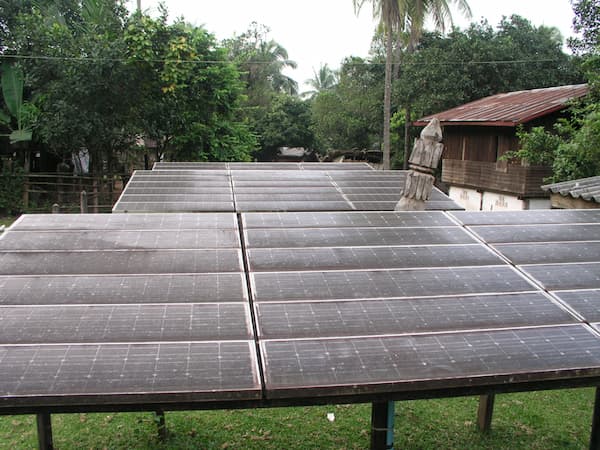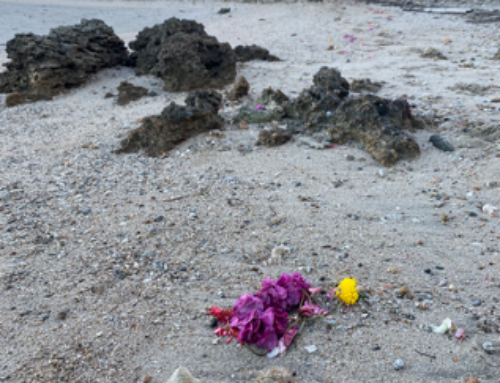
Off-grid distributed solar power generation in rural Laos, with the village pillar establishing the spiritual center of the village space. The photograph shows horizontally-arrayed solar panels in a lush village space, with houses and trees in the background and a carved wooden pillar near the center. Photo by author.
Central Laos, 2004
Amid a background of nicely-built wooden houses with tin roofs, interlaced with lush village fruit trees, three angled racks of solar panels break in a horizontal pattern across the image frame. The glint of sky is moody and overcast—it is September, still the monsoon—and some algae can be seen growing on the solar cells. Between the mounted solar panels juts an imprudent carved wooden pole, cocked at an angle between the shimmering silicon surfaces. It is a lak baan, the village pillar, a symbolic phallus (lingam) and the spiritual center of the village as a spatial form. A lone electrical wire is just visible against the trees.
What difference might it make to center energy generation in privileged social spaces? During my fieldwork in central Laos in 2004, I studied the social and ecological transformations that stem from large hydropower development, at a time when large dams were proliferating along these mountainous and, at the time, largely still free rivers. Transnational developers and the Lao state were eager to convert the postsocialist country into “the battery of Southeast Asia.” I worked with an international environmental consulting firm as we traveled through affected villages trying to understand the subtle but pervasive changes they had experienced. It was a central contradiction that in the shadow of these large dams most of the villages had no electricity supply, save whatever they were able to orchestrate for themselves. By contrast, this village showcased its solar electrification project at the symbolic and metaphysical heart of the community.
In Buddhist Southeast Asia, the classical political form was organized around the powerful center of the polity, defined by the masculine potency of the ruler whose charisma and prowess could hold together the periphery against centripetal forces that threatened to pull it apart. At the spiritual center of the kingdom was the lak meuang—in classical royal ideology, establishing a connection with Mount Meru and thus forming the center of the universe. This spatial arrangement was replicated at smaller spatial scales. Today, individual villages like this one frequently have their own lak, and wish for their own charismatic leaders. Across the Mekong, Thai architects and urban planners continue to look toward the power of the lak baan – lak meuang as a resource for affirming values of respect, creativity, and community improvement associated with sustainable development. Although the spatial formation has largely been reworked within the territorialized nation-state, the spiritual potency of the center-periphery arrangement forms a powerful axis of vernacular political meaning.
The solar project, then, was emplaced within this horizon of power. Yet small-scale sustainable development, especially in this part of Laos, is constantly at risk of being overwhelmed by the destructive capacities of the market. Village leadership is often under considerable pressure to champion local interests in the face of a complex political economy that may include large scale resource investments, highly constraining government land use policies, or international aid programs with contradictory impacts. This particular village was worried about a foreign firm that had started an exploratory gold mine on their land. The hydropower dam upstream had severely lowered the water table, making boat travel difficult and forcing them to dig deeper wells. The local charisma of the village chief matters when political relations often are personalistic; so too does the protective and creative capacities of the lak baan.
The local charisma of the chief, Thao Phanxay, did not disappoint. In addition to the solar installation built with Japanese aid, they had adapted an impressive technique for hand digging do-it-yourself bore wells with manual water pumps using readily available materials. Saksit, or potency, a central organizing principle of masculine power, rests heavily on the fact that the mundane and the spiritual cannot always be readily distinguished. Phanxay deftly disassembled a water pump to show how it was constructed from spliced-together bamboo poles, with the pump valve made from a repurposed spindle of sewing thread and a piece of rubber cut from a tire tube, held together with fishing twine. Costing three days’ work and about $25 dollars for the materials, the wells could pump groundwater from as deep as 20 meters (65 feet).
Thao Phanxay’s charisma seemed to profit from, but also make possible, the bold extension of technology in the manipulation of the natural and supernatural worlds. The solar panels were their only source of electricity, and the project was part of a Japanese aid program. It generated three kilowatts of power, not enough to power my small Brooklyn apartment, even if the sun shined 24 hours a day, but enough to charge two dozen car batteries a day. Villagers charged their batteries during the day and by evening would have enough juice for lights, a TV and VCD player, and their cell phone chargers.
Ethnography in a low-energy density setting makes visible the prominent energetic transformations that frequently make up vast aspects of social labor, like plowing, gathering firewood, washing clothes, cooking, and getting places. Control over energy-consuming machines also forms choke-points for local power, with gas-powered rice mills, boats, motorcycles, irrigation pumps and tractors the highest value assets in most villages. Concentrated power not only obviates many time-consuming activities, it also enables qualitatively new possibilities. The difference between solar power and “small engines in the garden” that undergirded peasant agriculture were stark. Electricity opened up this community to the world of cosmopolitan broadcast media, but at the time of my research had not changed the dynamics of village production.
It is not surprising that such a potent affirmation of modernity and modernization would be linked so provocatively to the sources of spiritual guardianship and creative potency. In fact, in some expressions of the lak baan, the lingam is paired with the feminine yoni as an expression of generative potential. Does not the horizontal plane of the polysilicon panels seem to frame the charismatic pull of the pillar? It makes me think about the increased backlash to renewable energy in the United States, not by defenders of the fossil fuel economy but by well-meaning liberals who, in spite of their concern over climate change, simply don’t want wind turbines or solar farms in their line of sight. Wouldn’t it make a world of difference if, rather than pushing our power generation onto other places and peoples, the globally affluent would make it a matter of aspiration to center, celebrate, and take responsibility for their own collective energy demands?
Jerome Whitington is Clinical Assistant Professor at New York University’s Gallatin School of Individualized Study. His research in Southeast Asia and the United States focuses on cultures of energy and ecology with particular emphasis on damaged late industrial environments. His research has been published in American Anthropologist, Public Culture, Anthropological Theory and Environmental Humanities. He has co-edited several collections and his book, Anthropogenic Rivers: The Production of Uncertainty in Lao Hydropower, was published in 2018.




